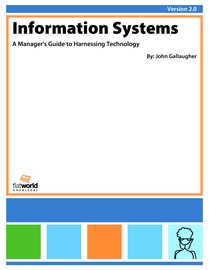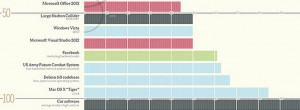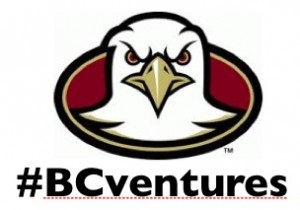
SnapChat’s Surge, Amazon Everywhere, Zara Booming, Tweets More Than 140 Chars, Lines of Code Charted & #BCventures: The Week in Geek™ – Nov. 18, 2013
 A continued thanks to faculty at the 200+ universities who have adopted my textbook “Information Systems: A Manager’s Guide to Harnessing Technology”. The latest version was released in August and includes a new chapter on Amazon.com, additional coverage of Disruptive Technology/Disruptive Innovation, and more. Find details of the current offering at https://gallaugher.com/book I’m grateful for the support & encouragement as we deliver an award-winning, annually-updated online text for only $19.95 in a market where $200+ outdated editions are common. That’s less than half what students would pay via a Chegg rental of a conventional business text. My very best to faculty & students supporting the effort!
A continued thanks to faculty at the 200+ universities who have adopted my textbook “Information Systems: A Manager’s Guide to Harnessing Technology”. The latest version was released in August and includes a new chapter on Amazon.com, additional coverage of Disruptive Technology/Disruptive Innovation, and more. Find details of the current offering at https://gallaugher.com/book I’m grateful for the support & encouragement as we deliver an award-winning, annually-updated online text for only $19.95 in a market where $200+ outdated editions are common. That’s less than half what students would pay via a Chegg rental of a conventional business text. My very best to faculty & students supporting the effort!
SnapChat, How Quickly You Have Grown
 Faculty looking to inspire students to dive into the golden age of collegiate entrepreneurship have another poster-child, 23 year old Evan Spiegel. The CEO and co-founder of SnapChat has allegedly turned down a $3 billion offer from Facebook, and a $4 billion bid from Google. The undergrads behind the firm originally presented the app in a mechanical engineering class called “Design and Business Factors.” I hope they got an “A”.
Faculty looking to inspire students to dive into the golden age of collegiate entrepreneurship have another poster-child, 23 year old Evan Spiegel. The CEO and co-founder of SnapChat has allegedly turned down a $3 billion offer from Facebook, and a $4 billion bid from Google. The undergrads behind the firm originally presented the app in a mechanical engineering class called “Design and Business Factors.” I hope they got an “A”.
SnapChat’s founders are now running a service that sends 350 million photos a month, that’s up from 200 million in June and just 20 million per month a year ago. And this as Facebook admits that teens are using the social network less.
But Teens can be fickle customers. In 2006 85% of online US teens had MySpace accounts. Today you’d struggle to find a teen on MySpace. Trying to predict SnapChat’s value is tough. Messages disappear (so switching costs should be weaker), the platform isn’t ‘open’ like Facebook or Twitter, and the premise for even wanting self-destructing e-mails seems to many, pretty icky. Jim Cramer has even suggested that self-destructing messages are being used for insider trading. Others are more upbeat. While the firm has zero revenue (yes, a firm that has been offered billions has never collected a dime), some think the space you watch for a message to appear is a natural for impossible-to-ignore advertising. A more likely acquisition scenario posits that the offer isn’t about what SnapChat is today, but what it could become in the future. Facebook arguably took out Instagram before it could become a mobile rival (offering Insta status updates, Insta link sharing). Nothing’s stopping SnapChat from turning on features that keep it hot with current fans, but expands utility in ways that bring in a new crowd in Facebook-rivaling ways. Posts using the new SnapChat stories linger for 24 hrs. and are a natural for advertising. Many think Amazon bought Zappos and Quidsi for the same reason motivating Facebook’s billions-bid – swallow potential competitors before they branch into direct threats to your current business.
Amazon Runs Warehouses Inside Supplier Warehouses
S ome updated info for those teaching with our Amazon Chapter. For the past three years, Amazon has been experimenting with a new logistics model where it runs an Amazon-staffed fulfillment operation in a fenced-off area of P&G warehouses worldwide. Diapers, razor blades, and other high-volume, fast-moving items are passed over from P&G to Amazon. While P&G warehouses are set up to ship pallets of diapers to Walmart, Walgreens, and other retailers, they’re not configured for sending lots of product to individual consumers, but these kinds of activities are Amazon’s super-power.
ome updated info for those teaching with our Amazon Chapter. For the past three years, Amazon has been experimenting with a new logistics model where it runs an Amazon-staffed fulfillment operation in a fenced-off area of P&G warehouses worldwide. Diapers, razor blades, and other high-volume, fast-moving items are passed over from P&G to Amazon. While P&G warehouses are set up to ship pallets of diapers to Walmart, Walgreens, and other retailers, they’re not configured for sending lots of product to individual consumers, but these kinds of activities are Amazon’s super-power.
The program, known as “Vendor Flex”, is meant to cut costs and reduce warehousing & shipping time to help the Bezos giant keep pace with Costco, Walmart, and others. Eliminating additional transit steps from supplier to Amazon to you should also reduce environmental impact from carbon footprint and transit congestion. The WSJ suggests that if online orders of non-perishable staples hit 6% (the share the Internet commands of overall retail), Amazon would generate an extra $10 billion. Amazon ‘Vendor Flex’ is also in warehouses of Kimberly Clark (Huggies, Kleenex, Scott), Georgia Pacific (Brawny, Dixie ,Quilted Northern), and eco-friendly non-perishables firm Seventh Generation. Also in Amazon fulfillment news, Amazon will begin getting items to you on Sunday, courtesy of a special deal with the US Postal Service.
Amazon Web Services Get Personal & Pretty
 How dominant are Amazon’s Web Services? “Five times larger than 14 other cloud computing providers combined.” And those offerings could soon be even bigger now that Amazon wants to put entire Windows PCs in a browser. Thanks to a new service called Amazon WorkSpaces, folks who want to run Windows but don’t want a PC, can now access a virtual Windows Machine through the cloud for prices ranging from $35-$75 a month. WorkSpaces users can open a browser window, even on an iPad or Kindle Fire, and get a fully functional Windows Desktop. Groups needing to lock down desktops that can’t be modified (think call centers) are natural customers. But my colleague, BC Prof. George Wyner, mentioned this might also be a great solution for faculty teaching Windows tools to students with Macs. Configure a desktop, point students to a browser, and you’re good to go! Says Amazon: “You can access this at half the price of a typical infrastructure desktop solution.”
How dominant are Amazon’s Web Services? “Five times larger than 14 other cloud computing providers combined.” And those offerings could soon be even bigger now that Amazon wants to put entire Windows PCs in a browser. Thanks to a new service called Amazon WorkSpaces, folks who want to run Windows but don’t want a PC, can now access a virtual Windows Machine through the cloud for prices ranging from $35-$75 a month. WorkSpaces users can open a browser window, even on an iPad or Kindle Fire, and get a fully functional Windows Desktop. Groups needing to lock down desktops that can’t be modified (think call centers) are natural customers. But my colleague, BC Prof. George Wyner, mentioned this might also be a great solution for faculty teaching Windows tools to students with Macs. Configure a desktop, point students to a browser, and you’re good to go! Says Amazon: “You can access this at half the price of a typical infrastructure desktop solution.”
Also offered is Amazon AppStream for game developers wanting to use the massive processing power of the Amazon Cloud for rendering complex images and gaming environments, while squirting this down to devices that would not otherwise be able to quickly create especially complex graphics on their own (think smart phones & tablets). With Amazon’s AppStream, who needs especially burly console hardware. Could this be a precursor to an Amazon game-enabled set-top box offering?
Scale and innovation keep Amazon way ahead of rivals. According to Wired, Amazon’s cloud offerings cycled through 28 releases in just the first half of the year, while AWS cut prices 18 times over six years. Storage prices alone dropped about 40% earlier this year.
Zara’s Fast Fashion Edge
![]() Our students have studied Zara, and the firm’s parent Inditex, for over a decade, and have watched that firm’s innovative, tech-enabled strategy propel Inditex to become the world’s largest pure-play fashion retailer, making founder Amancio Ortega the world’s third richest person. While economically-struggling Spain has always been Zara’s biggest market, this year China leapfrogged France to become Inditex’s #2 market with 142 stores. Zara’s a big deal because it is so vertically integrated & responsive. Store staff gather information on what customers would like to see on shelves & share this with a design team that gets duds from firm-owned factories and tightly-coordinated regional contractors into stores in as little as 2 weeks. While contact manufacturing is used for staples like t-shirts, over 50% of product is manufactured in 11 firm-owned factories, and all of the items ending up in Zaras worldwide are run through logistic centers in Northern Spain. Zara’s parent produces some 450 million items for 1,770 stores in 86 countries, and has continued to open more than a store a day, even through the down turn. For faculty teaching with the Zara case, here’s a neat video illustrating many of the key facts that our chapter covers.
Our students have studied Zara, and the firm’s parent Inditex, for over a decade, and have watched that firm’s innovative, tech-enabled strategy propel Inditex to become the world’s largest pure-play fashion retailer, making founder Amancio Ortega the world’s third richest person. While economically-struggling Spain has always been Zara’s biggest market, this year China leapfrogged France to become Inditex’s #2 market with 142 stores. Zara’s a big deal because it is so vertically integrated & responsive. Store staff gather information on what customers would like to see on shelves & share this with a design team that gets duds from firm-owned factories and tightly-coordinated regional contractors into stores in as little as 2 weeks. While contact manufacturing is used for staples like t-shirts, over 50% of product is manufactured in 11 firm-owned factories, and all of the items ending up in Zaras worldwide are run through logistic centers in Northern Spain. Zara’s parent produces some 450 million items for 1,770 stores in 86 countries, and has continued to open more than a store a day, even through the down turn. For faculty teaching with the Zara case, here’s a neat video illustrating many of the key facts that our chapter covers.
The Hidden Technology That Makes Twitter Huge
 While lots of ink has been spilled over how Twitter’s recent post-IPO $24 billion valuation defies conventional economic logic, or how the firm is deeply impacting our broader culture as well as specific industries such as motion pictures, faculty teaching database classes might find it interesting to have students take a deeper look at the humble tweet. The 140 characters in a tweet actually represent less than 10% of the data associated with the post. Each tweet, in fact, sports some 31 publicly documented data fields.
While lots of ink has been spilled over how Twitter’s recent post-IPO $24 billion valuation defies conventional economic logic, or how the firm is deeply impacting our broader culture as well as specific industries such as motion pictures, faculty teaching database classes might find it interesting to have students take a deeper look at the humble tweet. The 140 characters in a tweet actually represent less than 10% of the data associated with the post. Each tweet, in fact, sports some 31 publicly documented data fields.
These include data identifying the original poster, the time a tweet was posted, retweet count, favorite count, geographic information, and posting client. This last one has led to some embarrassment among the unaware, such as when Oprah praising the Windows Tablet, in a tweet sent from an iPad.
Tweets also sport a ‘withheld_in_countries’ field, indicating places where a Tweet is banned, a ‘withheld_copyright’ that indicates concerns over intellectual property, and a ‘possibly_sensitive’ field that is used to flag content that may be widely objectionable, such as nudity or violence.
How Much Code Is In That?
Did you know the Chevy Volt has more lines of code than World of Warcraft? That there are more lines of code in the average high-end automobile than in some commercial aircraft and fighter jets? That’s the case, assuming that the Sunlight Foundation’s “Codebases” infographic is accurate. Check it out.

❖ ❖ ❖ ❖
 And for those in the Boston College community, our young alums continue to prove that The Heights is now among the very best places for young entrepreneurs to hone their craft. A few highlights from the recent press:
And for those in the Boston College community, our young alums continue to prove that The Heights is now among the very best places for young entrepreneurs to hone their craft. A few highlights from the recent press:
- TechTrek alum Bill Clerico, co-founder of WePay, delivered a keynote at the recent Harvard Business School Cyberposium (the other two were delivered by Android Co-founder & Google Ventures Partner Rich Minor, and Uber CEO Travis Kalanick). Clerico revealed his firm is processing payments at a rate of over half a billion dollars a year. The firm has grown way beyond its peer-to-peer payment routes. The firm’s API now enables anyone with a website to embed payments as seamlessly as adding a YouTube video. Crowdfunders love it, with category growth up nearly 650% in a single year. Entrepreneur Magazine recently named WePay one of “30 Startups to Watch“.
- 2011 BCVC winner, Jebbit (a TechStars Spring ’13 alum), has raised $1.75 million, was named one of CNBC’s Top 25 Most Promising Startups”, “Boston’s Hottest Startup”, and has recently moved into new digs in the Fenway.
- Grad TechTrek alum Ryan Traeger has launched ACHVR, a motivation app to encourage you to check off your digital bucket list while rallying, supporting, and swarming with others. ACHVR has raised $1.2 million in seed funding.
- TechTrek West & Ghana alum, vet of the True Entrepreneurship Corps (and my TA) Mike Lapointe, was recently named to the team of the super-elite student investment team of First Round Capital’s Dorm Room Fund. Coverage from Bostinno & Boston.com. Go Mike!
- BC Sophomore Claudio Quintana, has been named a Fellow at .406 Ventures. The budding entrepreneur was recently profiled in a BC Chronicle piece. West Coast alums – look for Claudio in March when he’s part of our 2014 Undergrad TechTrek class.
- BCVC 2014 winners Phyre were recently named to a list of Top 20 Collegiate Startups. Pivoting from their original presentation idea, look for their slick new app, Rally, to come out of beta in the coming weeks.
- The BC MBA Team of Meghan Zipin and Emily Fannon made it to the finals of MassChallenge in their quest to commercialize a super-long-lasting battery technology born in the lab of BC Chemistry Professor Dunwei Wang. The firm won a MassChallenge “sidecar” prize – a Center for the Advancement of Science In Space award for Technology in Space, netting $45,000 and an all-expenses paid research partnership at the International Space Station National Laboratory to test the firm’s proof of concept in extreme conditions.
- Several young alums were named to Boston.com’s “25 Under 25” list, including: Deckard Sorensen of NBD Nano (2012 BCVC winner and TechStars Fall ’12 alum), Tom Coburn & Jonathan Lacoste (Jebbit’s CEO and COO, respectively), and Harvey Simmons (Dean of Marketing Affairs at TechStars, MassChallenge, and Bain Capital-funded EverTrue).
- A special shoutout is also in order for the hard working @BostonCollege social media team, named #5 Best & Most Collaborative of midsized schools. The team has created a one-stop social media shop for all things @BostonCollege – bc.edu/social Nicely done! Visit often, Follow & Forward. Got more news on BC Entrepreneurs? The BC Social Team is leveraging the #BCVentures hashtag. Let us know what you’re up to!
- Oh, and I got to talk a bit about Boston’s growing tech scene on NECN. Short message – our area is now the only place in the country where you can get off the subway and walk to Google, Microsoft, Amazon, Twitter, Apple, Facebook, then ride the elevator up to meet with one of the nation’s most elite venture capital firms. For all the well-meaning folks crafting rankings metrics, it’s time to put some real weight behind geography and what this sort of advantage means to a student’s ability to secure internships & jobs, engage in enriching outside-of-class visits, land mentorship for their startup ideas and career path, and more.
